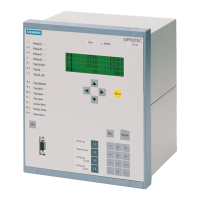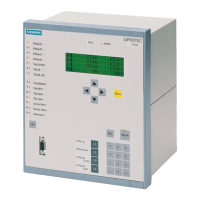Functions
2.14 Differential Protection and Its Protected Objects
SIPROTEC, 7UM62, Manual
C53000-G1176-C149-7, Release date 03.2010
123
Zero Sequence Current Treatment
The treatment of the winding starpoints is of no concern if the zero sequence current is eliminated from the
phase currents. By this means fault currents which flow through the CTs during earth faults in the network if
there is an earthing point in the protected zone (transformer starpoint or starpoint earthing transformer) are neu-
tralized without any special external measures. Elimination is done by setting STARPOINT S* = earthed (see
Figure „Vector Group Adaptation with Earthed Starpoint“in the Functional Description of this subsection).
In resonant-earthed systems or isolated networks, elimination of zero sequence current may be dispensed with
provided that the starpoint of the protected transformer winding has no connection to earth, not even via a Pe-
tersen coil or a surge arrester! In this case, each double earth fault with one base point in the protected zone
will be cleared by the relay, regardless of any double earth fault priority (see side title „Ungrounded Starpoint“
and Figure „Vector Group Matching for Y(N) d5 (isolated starpoint)“).
Pickup Value Increase on Startup
For additional security against overfunctioning when a non-energized protection object is switched in, the in-
crease of the pickup value on startup can be set at address 2005 INC.CHAR.START. As this option is mainly
provided for generator and motor protection, the default setting is initially OFF if a 2-winding transformer is
selected as protected object.
The associated parameters can be found at addresses 2051, 2052 and 2053. Address 2051 I-REST.
STARTUP is used to set the pickup value for detecting a startup. The function is disabled by setting I/I
N Obj.
= 0.
The START-FACTOR specifies the increase factor of the pickup values on startup. For transformer protection,
we recommend to retain the default setting 2052 START-FACTOR = 1.0. For switching external loads such as
motors or transformers, it should be increased to 2.0. Due to the high time constants, branch b of the charac-
teristic may well be exceeded for a short time with nonmatched CTs.
Harmonic Restraint
The inrush restraint of the device can be enabled and disabled at address 2006 INRUSH 2.HARM.. It is based
on evaluation of the 2nd harmonic present in the switchon inrush current. When the device is delivered from
the factory, a ratio I
2fN
/I
fN
of 15 % is set and can normally be taken over unchanged. However the component
required for restraint can be parameterized. To provide for more restraint in exceptional cases, where switch-
on conditions are particularly unfavourable, a smaller value can be set at address 2071 2. HARMONIC.
Cross Blocking
The inrush restraint can be extended by the so-called "crossblock" function. This means that on harmonic
content overshoot in only one phase all three phases of the differential stage IDIFF> stage are blocked. The
duration for which the cross-block function is to remain operative after differential current overshoot, is set at
address 2072 CROSSB. 2. HARM. Setting is in multiples of an AC-cycle. Setting to 0 means that the protection
can initiate a tripping when the transformer is switched onto a single-phase fault, even if an inrush current is
flowing in another phase. When set to ∞, the cross-block function is always effective. The duration of the block-
ing is specified during commissioning. The default setting of 3 cycles has proven to be a practical value.
Besides the second harmonic, the 7UM62 can provide restraint with a further harmonic, the nth harmonic.
Address 2007 RESTR. n.HARM. is used to disable this harmonics restraint, or to select the harmonic for it.
The 3rd or the 5th harmonic are selectable.
Steady-state overexcitation is characterized by odd harmonics. Here the third or fifth harmonic are suitable for
restraint purposes. As the third harmonic is often eliminated in transformers (e.g. in a delta winding), the fifth
harmonic is more commonly used.
Converter transformers also produce odd harmonics which are practically absent in the case of an internal
short-circuit.
The harmonic content which blocks the differential protection is set at address 2076 n. HARMONIC. If the 5th
harmonic is used as overexcitation stabilization, e.g. 30 % (default setting) is common.

